— This post is updated in 2024 based on our most recent travels in Tanzania. The following sections are new: Pangani, Lushoto, Zanzibar, and Pemba. As for the other sections although the general info is still valid you can expect that the costs I mention are higher now. —
It’s easy to get off-the-beaten-path in Tanzania – just travel along the coast by road, one end to the other. That’s what this post is about: our route in Tanzania, from the Kenyan border in the north all the way to the Mozambican border in the south. If you’re planning to travel in Tanzania, then here are our ideas and suggestions for getting around, and great places to stop on the way.
What’s it Like Traveling by Public Transport in Tanzania?
How Much Does it Cost to Travel in Tanzania?
Tanga
Pangani
Lushoto
Bagamoyo
Dar es Salaam
Zanzibar
Pemba
Mafia Island
The Kilwas
Mikindani
Mtwara
Onward Travel to Malawi
What’s it Like Traveling by Public Transport in Tanzania?
Traveling around by public transport in Tanzania is fairly easy – there always seems to be a bus going your way – but you’ll probably encounter a lot of touts and waiting around. You won’t find toilets on buses but you’ll stop a lot for bathroom breaks, and vendors sell all kinds of snacky-food at any stop you make.
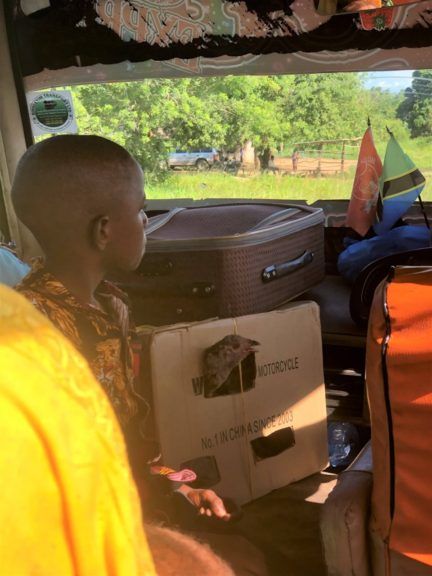
Vehicles are usually not in great condition and can get tightly crowded. Road conditions vary. Seatbelts are rarely used/available. Drivers are reckless. We passed accidents regularly: that doesn’t stop your average driver’s hideous driving or even slow him down. You should stay off the roads after dark.
Daladalas (minibuses) and coasters (sort of mid-sized buses) depart from local stations when they are good and ready (ie full AF). They are frequent and cover a lot of ground (slowly). You can also flag them passing in the road.
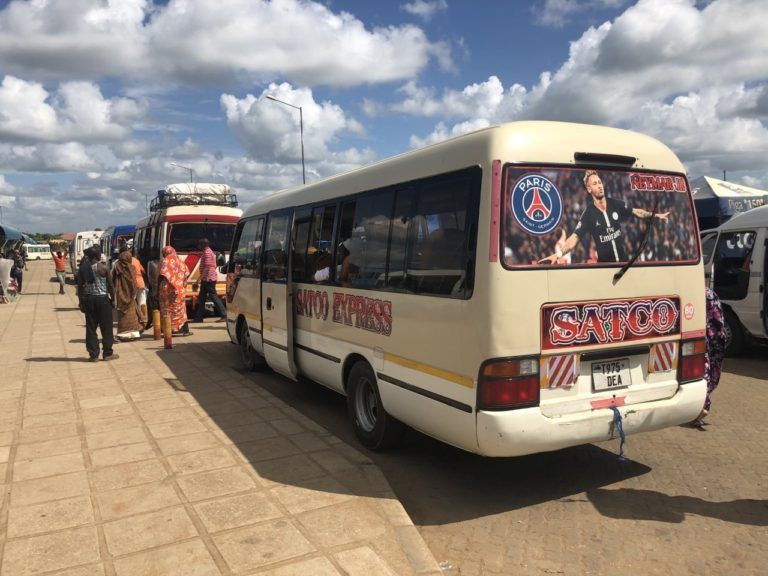
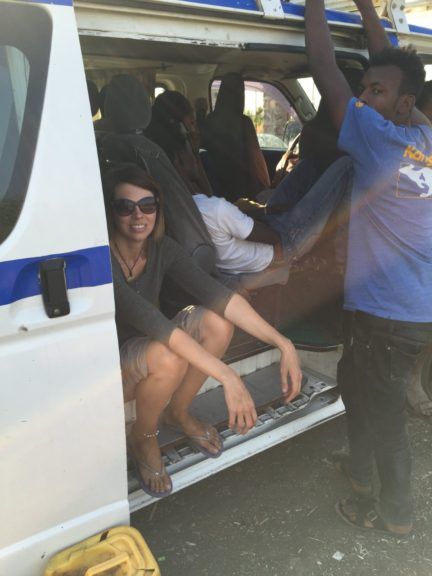
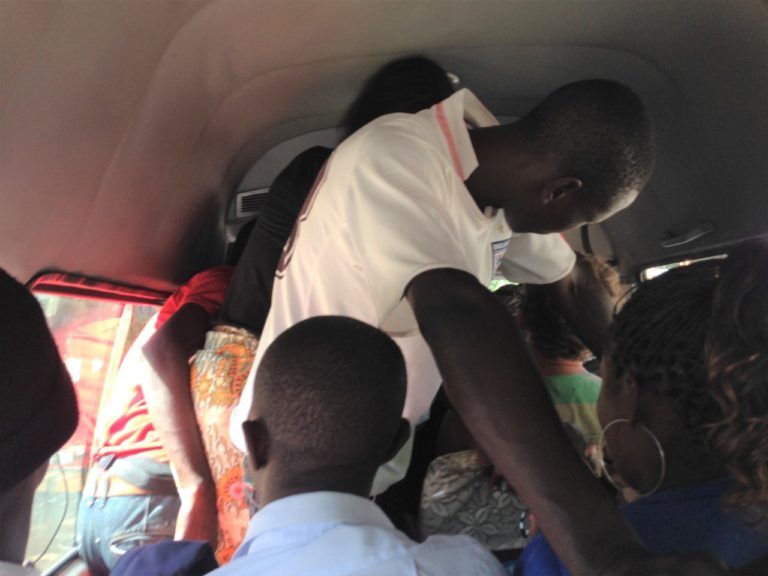
Regular buses are scheduled and depart (almost) on time. You want to travel long distances by bus (not daladala), so booking tickets a day or two in advance is a good idea. Buy your tickets at the bus company’s office at the station and then show up at least half an hour early to claim your (assigned) seat. More serious companies actually obey the law and won’t allow extra passengers into the aisle. Others will. This can work in your favour if tickets were sold out – some drivers don’t care and will just stuff you in to sit in the aisle, and pocket the money. Entire fleets of buses selling out was a regular problem for me throughout Tanzania and Kenya in December, thanks to Christmas and New Years.
Something we noticed more in Tanzania than anywhere else nearby: there is SO much police corruption. They’ll stop each bus (particularly daladalas) every few kilometers, to ‘check’ that it’s not overloaded with either passengers or luggage. Of course since buses are usually grotesquely overloaded with both, drivers can take the fine or just pay off the officer – who will actually get onboard and look at the mountain of luggage and people, and then just walk to the side of the road with the driver.
The police are also deeply concerned with professionalism and seatbelts. So if you notice your driver is suddenly putting on a uniform and buckling up – or just pulling his seatbelt across his body and sitting on it – then you know a police check is coming up and you should see if there is a broken belt under the seat to loop across your lap. The officer will stick his head in the window, look at the driver who is clearly just sitting on the buckle, flick his gaze past the ten people standing in the aisle, collect his bribe and nod for the bus to continue.
How Much Does it Cost to Travel in Tanzania?
Currency: Tanzanian Shilling (TZS)
If you’ve been to Kenya you’ll notice stuff costs less in Tanzania. Accommodation is cheap, even for a solo traveler. You can find a perfectly good double room in the 10-18 USD range in any of the towns I talk about below, and 20-30 USD in Dar es Salaam. Transport is cheap; so is local food (4000 – 8000 TZS/2-3 USD for a plate of meat/beans/rice/sauce). Even Western food is not expensive – you can have a good meal for around 18 – 22 000 TZS/7-10 USD.
We like to eat good food and drink coffee and wine indiscriminately. Keeping that in mind, our costs were approximately 30 to 40 USD per person/day, even in Dar es Salaam. That’s including transportation, and activities like boat trips/entrance tickets/hiring a guide etc. On days where we either traveled or just stayed put somewhere, it was easy to spend as little as 20 USD per person. Mafia is the exception to all this: accommodation, food and activities all cost more there (still not bad at all though).
You don’t need to book accommodation in advance (outside high season) unless you’re very particular about where you stay, or if you’re arriving at night. We find accommodation on Booking.com (or similar), on Maps.me, or just by looking around. If I’ve looked at Booking.com I’ll usually just keep a couple of options in mind, but not book.
You should get a SIM card: WiFi can be very hard to find and unreliable the further south/inland you go.
ATMs are available in the major towns we passed through and are mostly reliable but I still wouldn’t wait until my cash dwindled down to nothing before drawing more. It might depend on your bank at home, but the bank with the lowest ATM fees by far that we always used was CRDB Bank. Big hotels will take credit card but you obviously need cash for shops, food and transportation.
Tanga
Coming from Kenya by road, Tanga was my first stop in Tanzania. I stayed at Dolphin Inn, from where it’s easy to hop around town by boda-boda or take a walk in the old colonial centre (which is deserted basically). There’s not much to see or do but it’s an easy place to just break up the trip.
If you’re on your way into Tanzania from Kenya, take a look at these two related posts:
Traveling the Kenyan Coast: Inspiration from North to South
How to Cross the Border from Kenya to Tanzania
Pangani
There’s really not a lot to Pangani itself. It’s like a very, very, low-key version of Bagamoyo – a couple of barely maintained old colonial buildings, a sleepy market. It was once a shipping port on the slave trade with captives bound for plantations on Pemba and Zanzibar. There’s a museum combined with a restaurant called The Pahe just near the river ferry (soon to be replaced with a bridge). It was shut when we were there but looked really good.
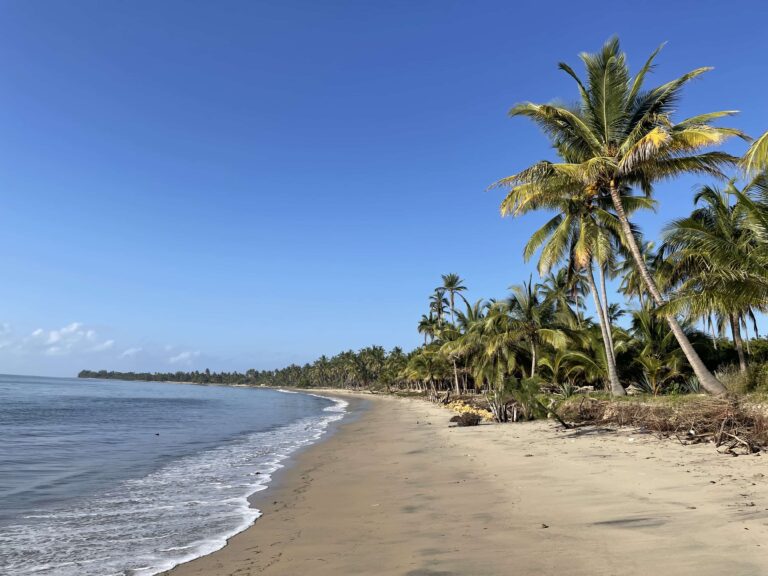
Any accommodation we saw in Pangani town itself did not look appealing. There are plenty of places to stay along the southern beaches and from there, you can get into town for a day by bus or boda-boda. We stayed at Ushongo Beach Bungalows which was pretty rustic but nice.
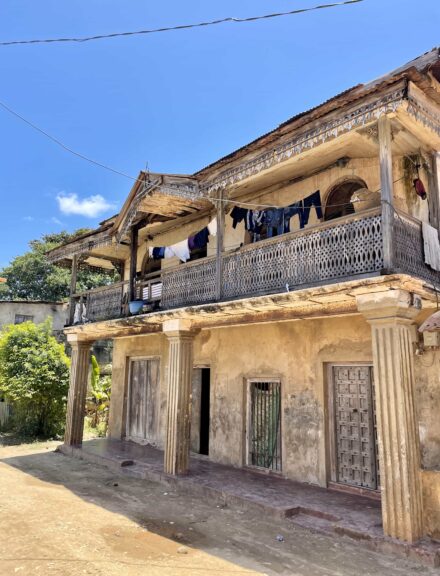
Getting to Pangani
Coming from Tanga, it’s a 4-5 hour direct bus, on a super-bumpy little road. That road is under construction however and should probably improve. From the bus stand in Pangani you’d need to walk or pick up a ride to the river-ferry (or bridge if it’s been built) and cross the river, at which point you can pick up a boda-boda or a slow and intermittent local bus to your accommodation if you’re heading to the beach.
Or, the bus you’re on might continue down the coast in which case you can ride it til you reach the closest junction to your beach hut. You might need to get in touch in advance with your host to arrange pick-up – for example ours was around 6 kms from the junction so they picked us up on bodas.
We got to Pangani from Lushotho which is a whole other shit-show. We took a bus from Lushoto to Korongwe. There, we found another (local) bus going to Pangani. That bus carried on down the coast so we stayed on til the junction for Ushongo Beach Bungalows. I called this a shit-show mainly because it was raining like crazy that day, lots of mud, the second bus was incredibly slow, plus we had a long breakdown so it turned into an eleven hour day. You might have better luck.
The other option you could try in this case is taking a bus from Lushoto to Tanga, and then from Tanga down. This way you might be able to avoid the local buses which stop literally everywhere.
Lushoto
Not at all on the coast, but not that far away either, Lushoto is a German colonial hill town in the Usambara Mountains. I’m including it here because it’s a really nice place and you can definitely swing by and stay there a few days if you’re traveling in either direction along the coast.
It’s green and beautiful and full of lovely walks and a National Park. The village itself is your usual base where transport comes and goes and you can get a ride to your guesthouse or homestay from there. And there are many, many, guesthouses and homestays in the surrounding hills. Your house will usually have meals available and can advise you about things to do. There is a great place called Irente Farm that you can walk to through villages and on to a small waterfall, stopping at the farm for a German-inspired and delicious lunch. There’s a viewpoint nearby and the farm also has a little craft and food shop.
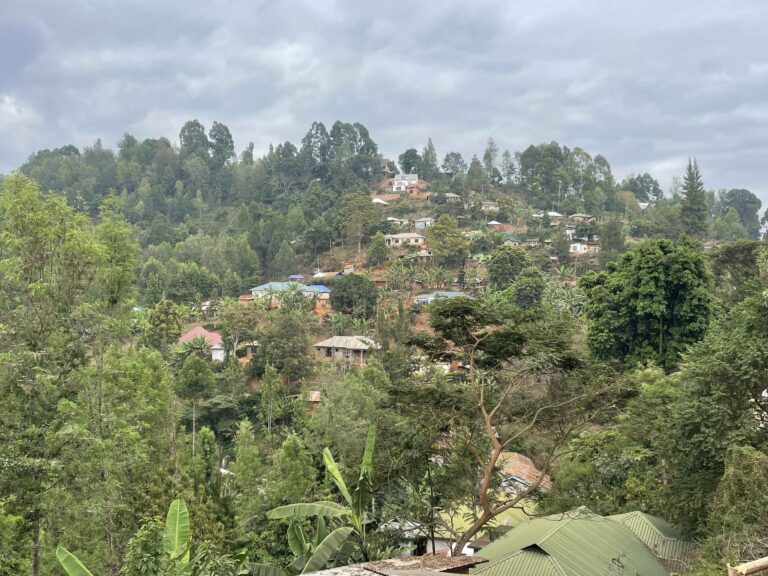
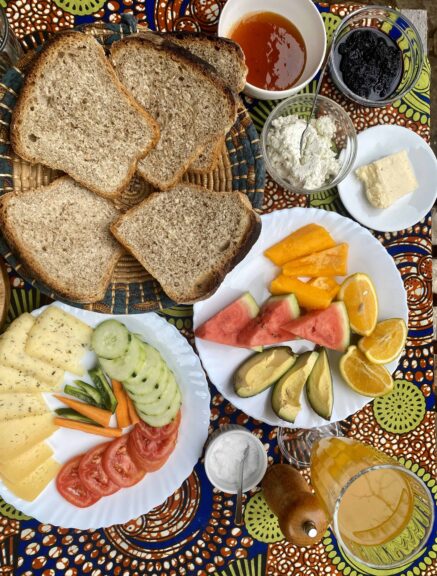
Also in town, there are many ‘tourist agency’ type places whose reps will find you without doubt. You can book guided hiking and day trips with them or at least find out about options. There’s also a friendly little coffee shop there called Usambara Coffee Corner. If you’re walking on your own: watch out for the boundaries of the National Park. The second you stray over those boundaries, even by accident just to go to a lookout for a few minutes, you will be charged a full day in the Park (10 USD per person). True story:)
Getting to Lushoto
We came from Dar es Salaam. That meant Ubering from our hotel in the city center to the big bus terminus called Magufuli. This takes about 45 minutes depending where exactly you’re coming from and of course, traffic – get an early start.
When you get to the station you see everyone surging these windows near the entrance. Buy a token there and go through the barriers with it, into the station. Don’t talk to anyone, don’t look at anyone, don’t accept ‘help’ from anyone. The touts here are beyond horrendous.
There aren’t ticketing offices at the station. You should look up reputable bus companies in advance or ask your hotel for recommendations. You can see tentative schedules online but as far as we could tell, the only way to actually book would be to get someone to call and reserve places for you. We just went there with a company in mind. We found their buses but they didn’t correspond to the schedule we’d seen online so we took another company instead. Basically you need to find the area in the station where the buses going your way, depart from. There will be multiple companies there and you can compare times and prices.
We also made a point of looking online in advance about the ticket price and good thing we did because they will overcharge you like crazy. Do not buy a ticket from a tout. Find a driver or conductor for the company you want (but even he will try to rip you off).
Watch your bags. You shouldn’t have to pay for your bags but they will try to make you. We even had a very drunk, random, man follow us onto the bus demanding a luggage fee – he was in no way affiliated with our bus (or at any rate, we didn’t pay him). In short, this bus terminal is a nightmare but if you just keep walking and ignore everyone, you’ll get through. Once on, it was all very straightforward: a five to six hour trip direct to Lushoto.
If you’re heading up the coast after Lushoto, you can catch a direct bus right to Tanga. Or, you can stop off in Pangani first, as we did.
Bagamoyo
Once just a little village that relied on fishing and coconuts, in the 1800s Bagamoyo became the coast’s foremost slaving port and one of the richest cities in East Africa. After that it spent some years under German colonial administration, and now is pretty much back to fishing and coconuts.
Due to the town’s long history there are a couple of things to see: some colonial buildings and the old Stone Town. There’s also a long and pretty beach, with lots of fishing boats and activity going on. I stayed at Barcelona Lodge in the modern-day village, which is busy and noisy and I liked it.
There are some small, cool guesthouses and cafes in the Stone Town and near the beach.
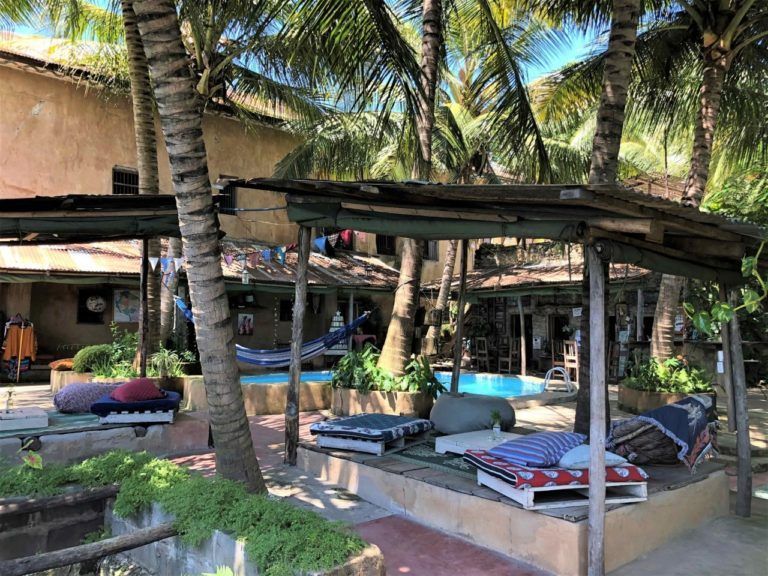
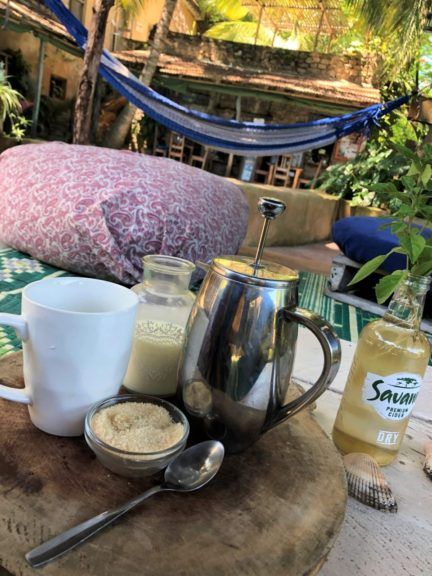
I’ve been to Bagamoyo before, and I didn’t like it…so of course, I had to give it another shot (eleven years later). Here’s my story about re-visiting Bagamoyo, and traveling down the coast of East Africa.
Getting to Bagamoyo
I got a boda-boda to Tanga’s bus station on Pangani Road. There are plenty of ticketing offices across the street. At least one bus runs from Tanga directly to Bagamoyo: I bought a ticket on the 10.30 am Satco Express coaster, and it left on time. Direct buses go right to the Bagamoyo bus station. It took around six hours.
You can also get on a regular (big) bus going to Dar es Salaam via Neema road. That costs around 20 000 TZS and you get out at the junction for Bagamoyo from where you’d catch a daladala or boda-boda the rest of the way.
Dar es Salaam
This time around, I went to Dar es Salaam to meet Oyv and we slept at Stay Inn in Kariakoo for a night before heading to Mafia Island. Dar is an easy city to spend a couple of days.
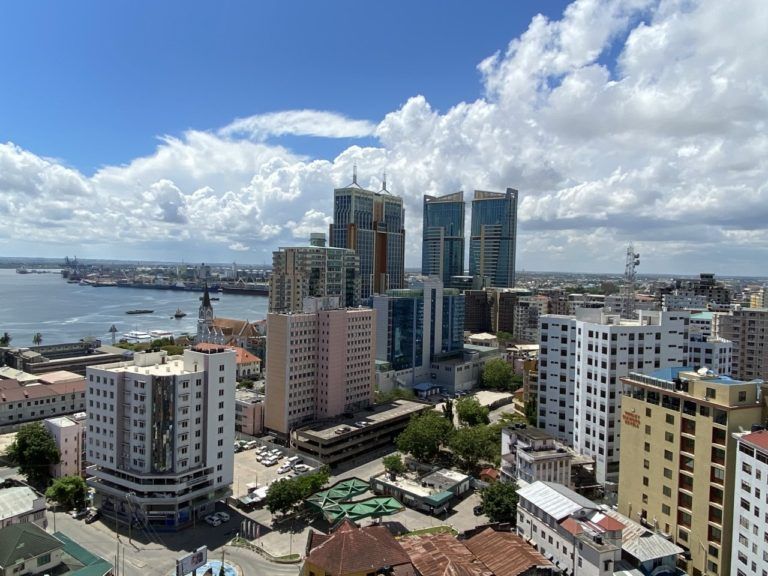
It’s walkable and there are good cafes and restaurants and lots of good Indian food. Chai Wala cafe is nice. We had a great thali at Chowpatty.
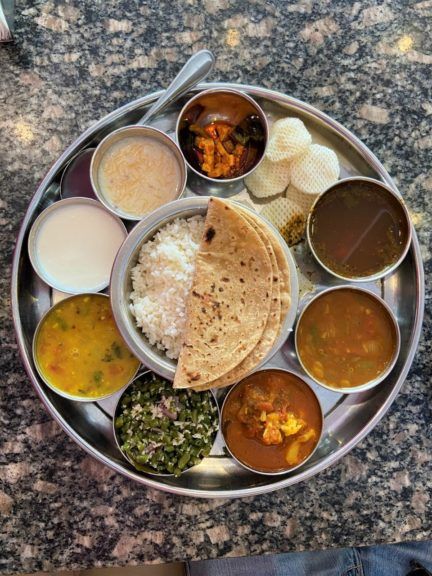
Chef’s Pride seems to be packed all the time, including the very first time we went there, eleven years ago. Zuane is good for pizza/Italian. Use Uber to get around at night.
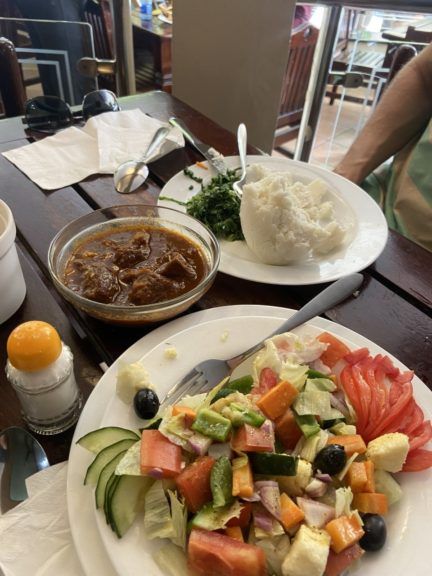
Here’s my story about meeting up in Dar es Salaam and going to Mafia Island.
Getting to Dar es Salaam
Going directly to Dar es Salaam from the Pangani road bus station in Tanga takes around five or six hours.
I came from Bagamoyo and it took just over two hours (all the way in to Kariakoo). Buses depart regularly for Dar es Salaam from right inside the gate at the bus stand in Bagamoyo, and cost around 1600 TZS. The bus I took stopped in Tegeta Nyuki market on the edge of Dar, where I got on a city bus going to Kariakoo. I think horrible traffic is pretty much guaranteed.
Zanzibar
Ok, Zanzibar is not exactly a secret and to be honest I’m not even sure I’d recommend going there. However, Stone Town is worth a visit and the beaches are beautiful – if overrun – so you might want to check it out.
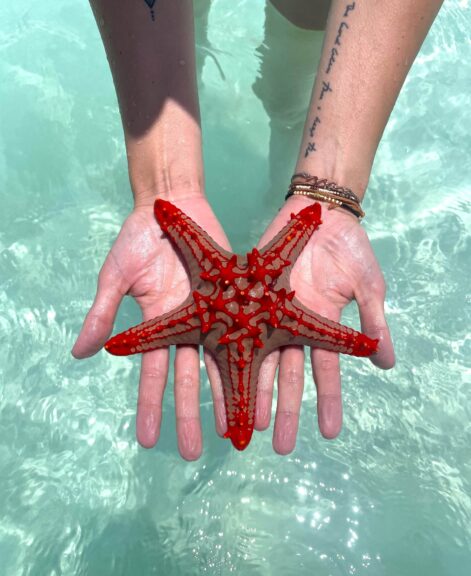
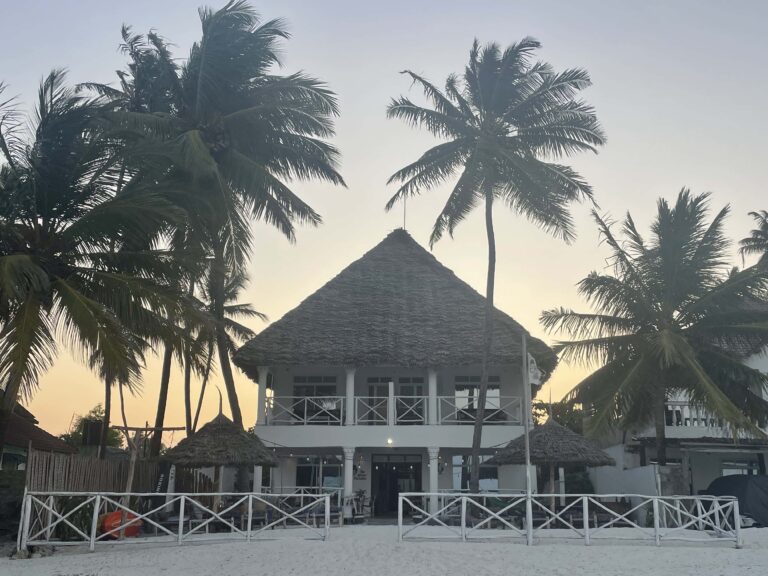
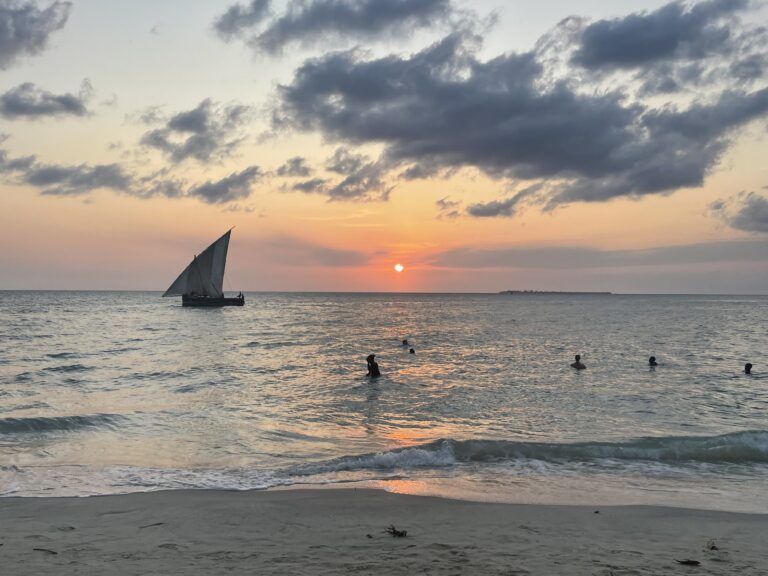
Getting to Zanzibar
There are many ferries running back and forth between Dar and Stone Town and the company we saw most recommended was always Azam Marine. You can go first or second class, it’s fast, and comfortable. No problem! Just watch out for annoying touts around the port in Dar.
Book your tickets online in advance – if you book at the offices in person they’ll force you to pay in USD with a horrible rate. You need to have a printed ticket so either print it in advance or show up a bit early and go to the Azam Marine offices at the port and they will print for you.
Pemba Island
Known as the ‘Green Island’, Pemba is, like Mafia, a very quiet and much more serene alternative to Zanzibar. That being said, if it’s beaches you are after, Zanzibar is probably a better choice. The places you can stay on Pemba are either not really beachfront, or, they are expensive.
If you’re trying to keep costs down and stay local, there are some rustic options in the village Mkoani, which is also where the ferries come in so it’s very handy. We stayed at Lalalodge. The owner is great and you can eat all your meals there (and they are very good) – which is also good cause you don’t really have a lot of alternatives. The owner, Dennis, will also help you to arrange all your trips around the island and to neighboring small islands, and he can help with the ferry and flights. From the lodge you can get to other beaches in the area which are very beautiful.
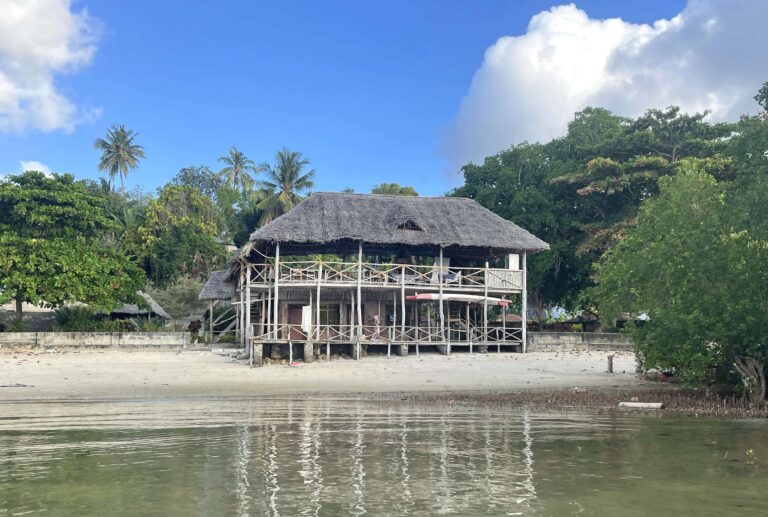
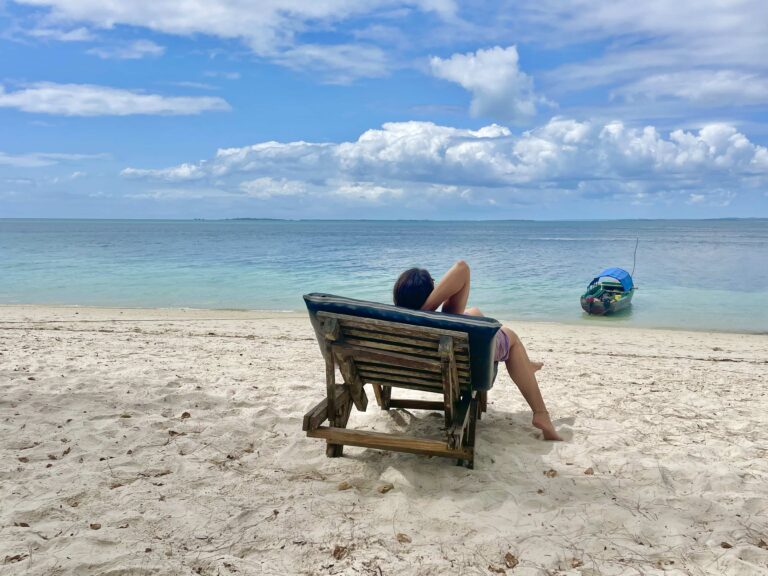
Bring cash. There are one or two ATMs on the island and (apart from the resorts) you can’t use card – or if you do, you’ll pay a big commission.
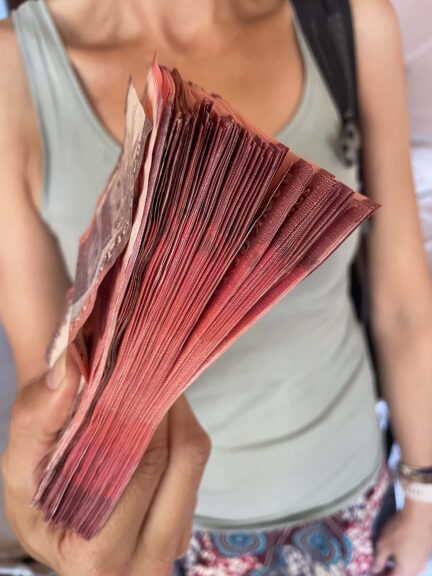
Getting to Pemba
We took the ferry out and flew back. Keep in mind, flying on any of the small-plane airlines like Safari Link, Coastal Aviation etc is convenient but really expensive. However, fairly recently some smaller commercial flights have opened up – Unity Air – and they are much cheaper, especially if you know someone who can book for you with residents’ rates.
At the moment only Azam Marine is running ferries to Pemba. They don’t run every day or very frequently, check the website. You’ll probably read a lot about how rough this crossing is/ferries capsizing and so on – but Azam Marine is highly recommended for safety and reliability. In our case (could be depending on season) we had to go via Zanzibar. However at other times of year I believe they do go between Dar and Pemba directly. From Zanzibar to Pemba took about 6 hours. Definitely go first class so you can sit in the huge, air-conditioned weirdly set up cabin. Otherwise, it’s deck passage right under the sun. The ferry is slow, disorderly, dirty, and often overloaded. There were delays and disembarking took forever. All that said, it was perfectly fine, I’d certainly do it again. It’s also cheap.
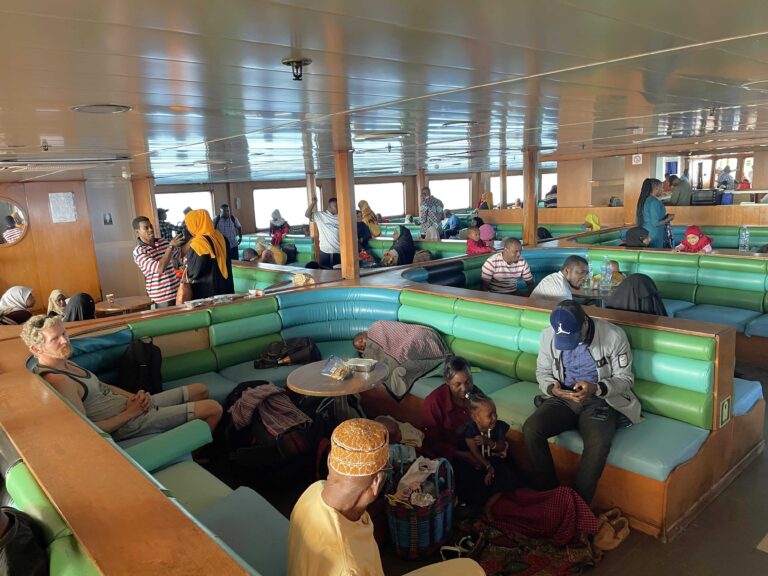
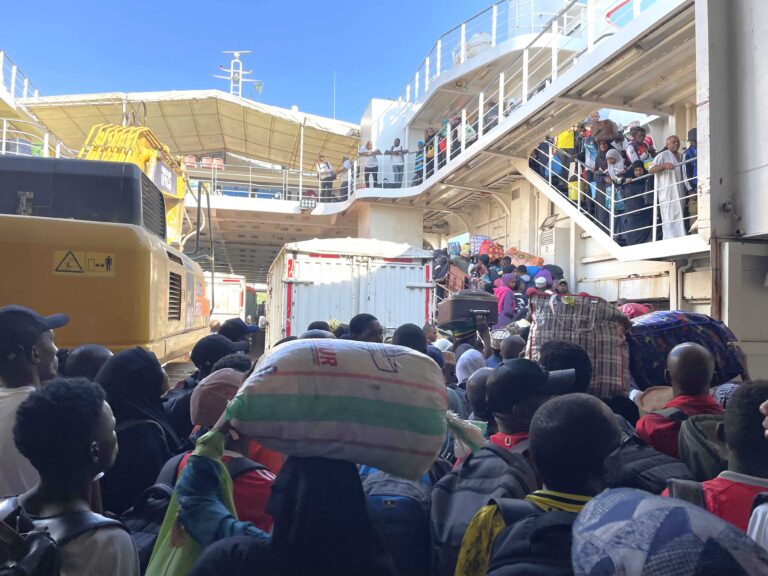
Mafia Island
— Update in 2024: Azam Marine is supposed to be opening up/has opened up routes on proper ferries for Mafia, which would be a step up from the regular public boat I talk about here. —
Mafia Island (the main island in the archipelago of the same name) is smaller than Zanzibar and a lot more low-key. On Mafia, it’s all about the activities in the marine park.
A large part of the Mafia Archipelago is a protected marine park. The big beach hotels are on Mafia’s east side near Chole Bay, inside the park. If you stay there, you pay the park fee (25 USD) each day.
There are several small guesthouses offering half- or full-board in and around Kilindoni, the main village on Mafia near the airport – outside the marine park, hence no extra fees. This is the only budget accommodation area in the archipelago: for a cute hut with breakfast expect around 25 USD per person, 15 USD per person for dinner. There are some local restaurants and a market in Kilindoni, where you can get food (and a swim suit, in Oyv’s case, since he forgot to bring his to the coast of East Africa). There’s an ATM but I’d bring cash anyway. Our guesthouse had sporadic WiFi next to the bar (which in turn, sporadically had beer).
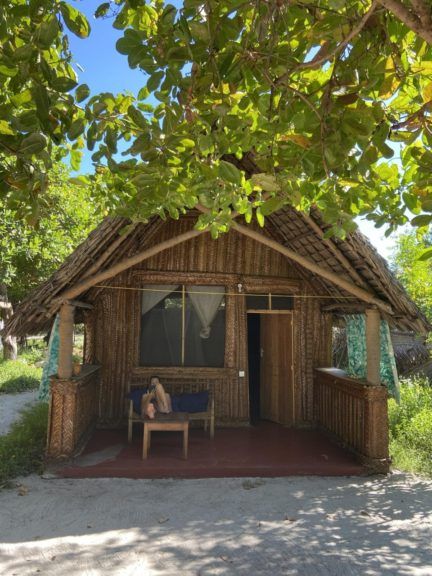
There is some amazing snorkeling here and even more amazing, you can swim with whale sharks. Don’t miss it. Make the arrangements with your guesthouse, and expect about 50 USD per person per activity.
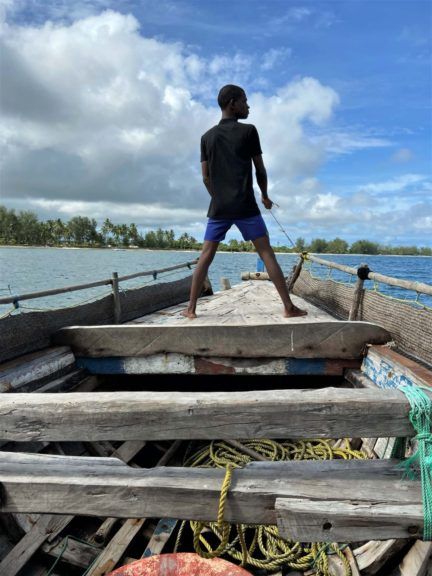
What’s it like swimming with whale sharks? Check out my story about Mafia Island.
Getting to and from Mafia Island
There are two options – flying, and the public boat. I’d suggest doing what we did: fly out to the island, and come back by boat. To take the boat to Mafia you need to get to the port at Nyamisati village the day before, and then sail off in the middle of the night (not an enticing prospect if you ask me).
The flight on a twelve-seater prop-plane (124 USD per person, Auric Air) takes about thirty minutes, is a lot of fun and offers great views. From the teeny airport on the island, we got a tuk-tuk to take us to Juani Beach Bungalows.
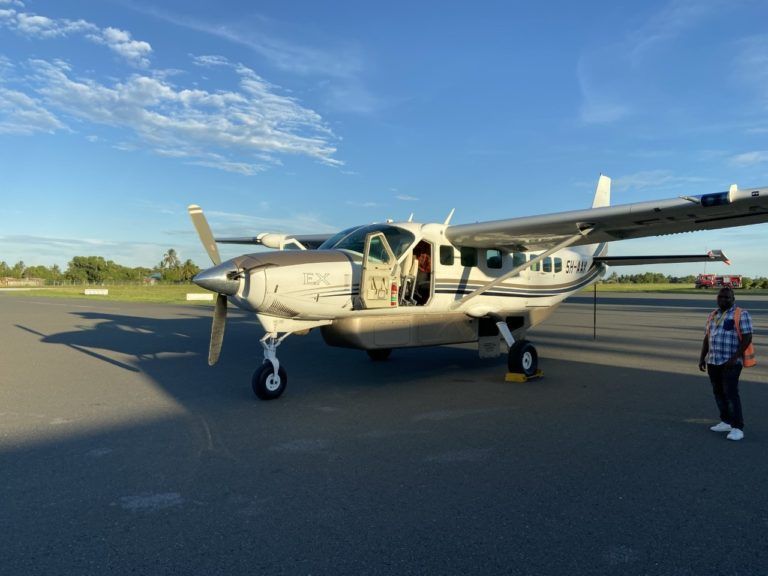
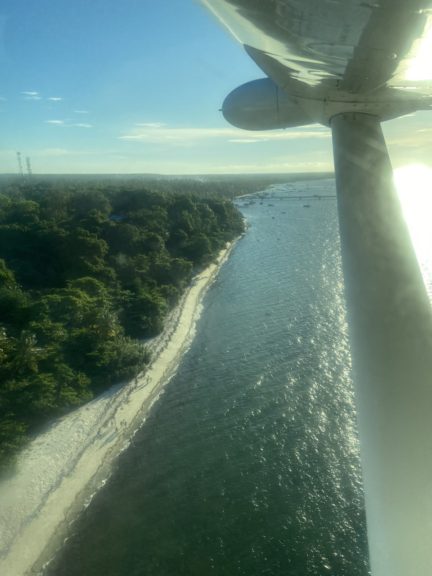
Going back by the public boat, a big wooden motorized dhow, is also fun if you like that sort of thing (we do). Ask your guesthouse to book the tickets (16 000 TZS) a day in advance. Be at the harbour near Kilindoni by 4.15 am – the watchman from the guesthouse walked us over. A daladala takes passengers out to the boat at the end of the long pier, and you climb aboard with your luggage and stake out a space (wooden benches around the sides, or the floor). The boat departs around 5.30 am and takes three to four hours to the mainland where you get off in Nyamisati.
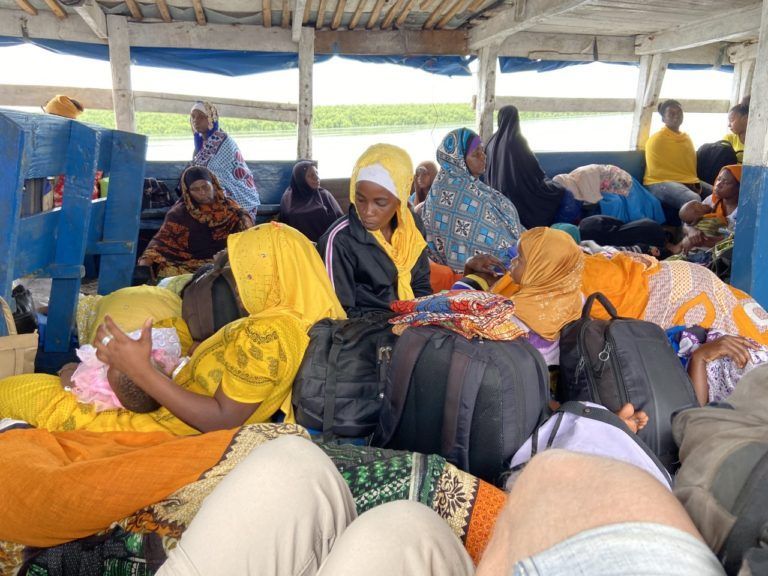
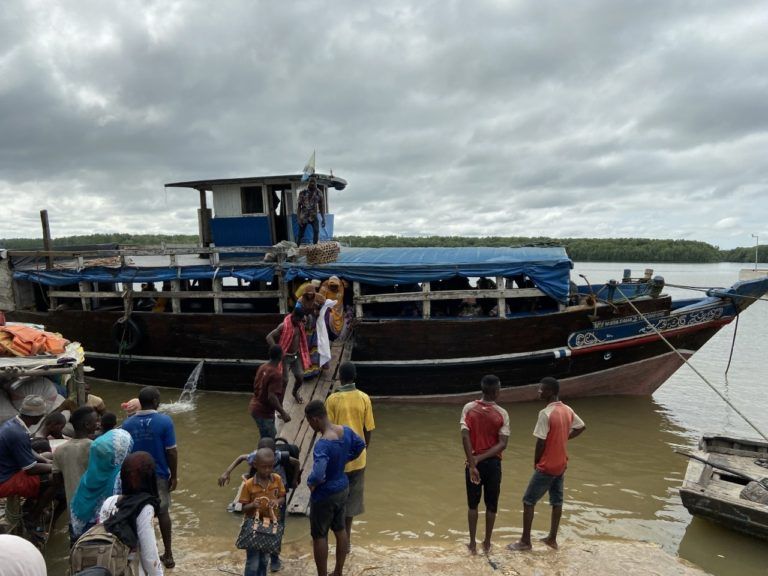
Follow the crowd through the village and you’ll find the bus stand (and a lot of aggressive touts). If you’re heading back to Dar es Salaam (around a four hour trip), you can start arguing for your seat and ticket price.
We didn’t go to Dar, we continued south to the Kilwas.
The Kilwas
Three little towns make up the Kilwas: Masoko, Kisiwani and Kivinje. They are off the main road, but we’d given up all hope of reaching Lindi that day and needed a place to sleep. It turned out to be one of our favourite random stops. Don’t be put off by crowds of kids waving and shouting ‘bye-bye’ when you arrive…it’s just their thing.
We stayed at Mjaka guesthouse in Masoko: it’s a busy town with transport links, cheap fine accommodation, and a good market. Jimbiza beach is gorgeous, with a lot of fishing boats and a tiny village just a few minutes walking from town. Right on the beach is Slow Leopard, a little guesthouse with a roof terrace overlooking the beach. They do a lovely breakfast and fantastic homestyle dinners, definitely the best food in town. They also have (very unreliable) WiFi, which no other place seemed to have. There is at least one ATM in Masoko.
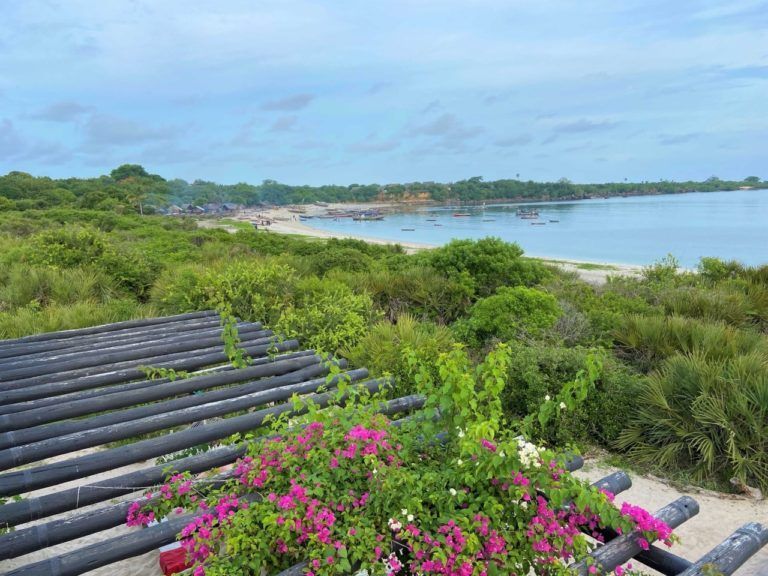
Definitely take a half-day trip to the island of Kilwa Kisiwani. The extensive and well-preserved ruined Swahili city here was once the most important trading centre on the East African coast. You’ll need a permit and a boat to get there. Slow Leopard and the Tourist Info office in Masoko (next to the Mash Allah bus office) will organise everything but they charge way more than the trip is worth (really expensive boat, huge commission on the permits). Better just do it yourself: go to the Antiquities Authority (next to the Kilwa Bandari Lodge) and book there. Permits are 27 000 TZS for non-resident adults, and they charge 57 000 (total, for two or more people) for the boat and guide. You can also try to arrange the boat yourself from the harbour or the fishing village on the beach.
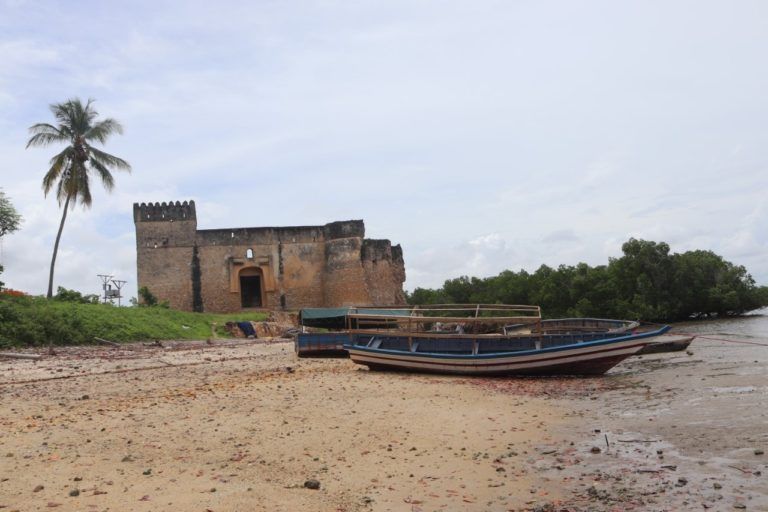
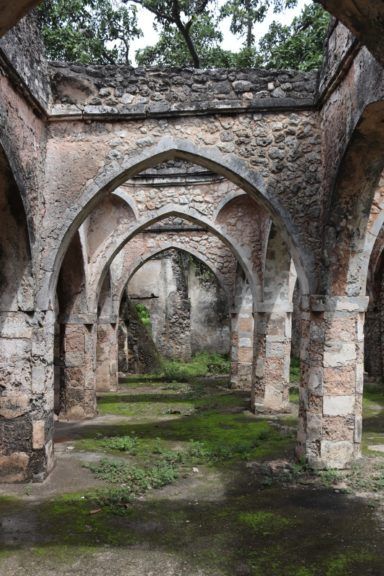
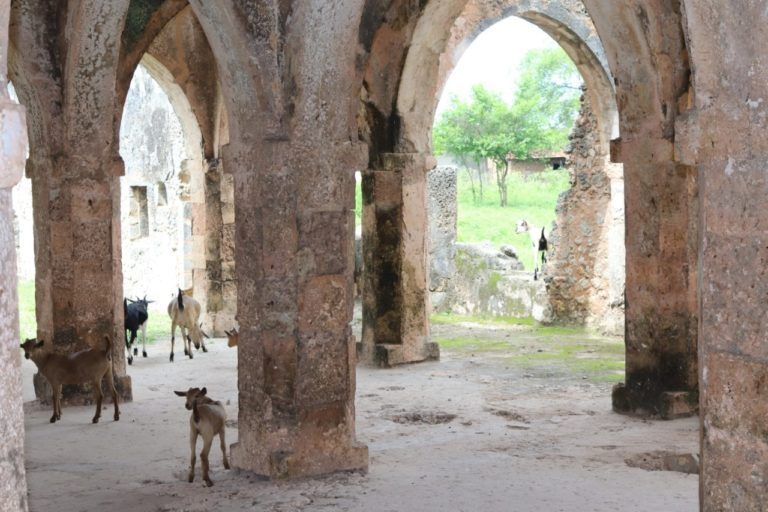
Getting to the Kilwas
It will take a day to get from Mafia to Kilwa Masoko. Coming from Mafia the public boat dumps you on the shore in Nyamisati. Follow everybody to the village bus stand. Get a bus to Bungu (or a bus for Dar, which will stop in Bungu). Be prepared to wait a little, and argue a lot: the touts were absolutely awful – they overcharge and charge for luggage too.
It’s about thirty kilometers to Bungu and it took two hours with all the stopping and a terrible road. Get off in Bungu, wait at the side of the road and flag down the next bus(es) going south – towards Lindi. If you get a slow-moving daladala you can try hopping off twenty kilometers down the road in Kibiti where there’s a big bus stand and more options.
Get off whatever bus you’re on, at the stand in Nangurukuru, two and a half hours from Kibiti. Turn right out of the open air station and walk towards the turnoff for the Kilwas. You’ll see taxis congregating – get a seat in a share-taxi the last thirty kilometers to Masoko. Daladalas run back and forth too.
Mikindani
Desolate colonial buildings in a faded little fishing village, with a good museum about local history – Swahili people, the slave trade, Livingstone’s explorations, and Geman colonial occupation. It’s a good stop for some peace and quiet before Mtwara.
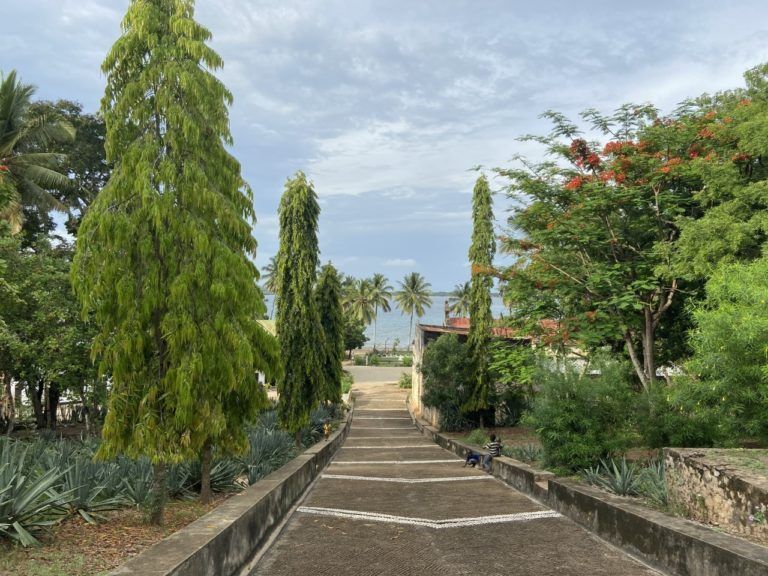
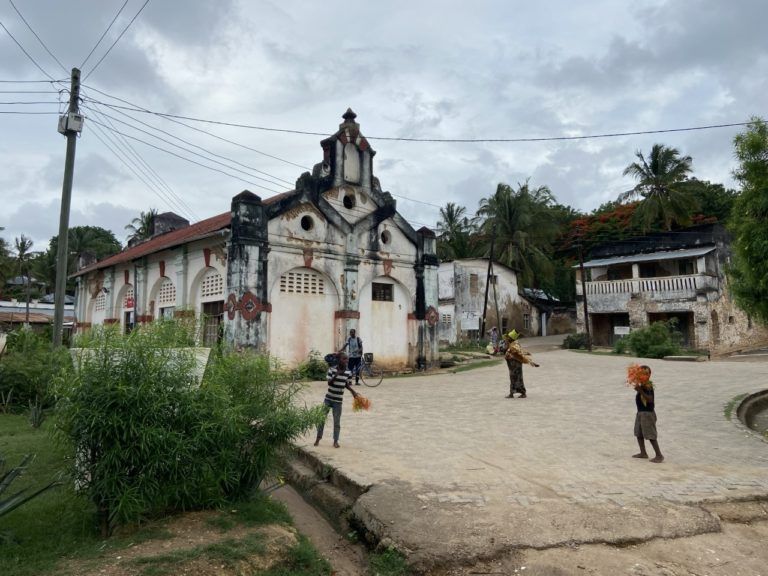
10 Degrees South seems to be the only real guesthouse and it does good food. There’s no ATM in Mikindani and no WiFi available.
Getting to Mikindani
We left Kilwa Masoko in a share-taxi from the stand by the petrol station. It’s thirty minutes back to Nangurukuru, and then a ten minute walk to the bus station on the main road. We easily got a bus to Lindi, about two and a half hours away. At the station in Lindi we got a coaster going towards Mikindani, which took another two hours. Follow along on your GPS: you’ll pass Mikindani in the blink of an eye.
Mtwara
Mtwara is the last big town in Tanzania before the Mozambique border. We originally planned to cross into Mozambique from here. However, due to conflict on the other side of the border, we ended up re-routing inland, around the lake and into Malawi instead (and on to Mozambique…eventually).
Stuck in Mtwara for a day or two sorting this out, we checked into Tiffany Diamond Hotel, because it has a coffee bar and WiFi and practically no where else does.
There are places to eat, a busy market, and ATMs in Mtwara. We spent a lot of time at the bus station where all the offices are ringed around the sides, sorting out tickets.
Getting to Mtwara
From the road in front of 10 Degrees South in Mikindani, flag down a passing daladala and crowd in for the thirty minute ride to Mtwara.
Onward Travel to Malawi
After Mtwara we traveled inland towards Lake Nyasa (also known as Lake Malawi), around the lake and into Malawi – all on our way to Mozambique. If you’re on your way to Mozambique too (or Malawi) – or you just really enjoy hearing about other people’s problems, you can read my story about our detour around the lake, here.
I also wrote a post that tells you everything you need to know to travel around the lake: From Tanzania to Malawi: How to Get Around Lake Malawi by Road
Read More
For more about my adventures (and misadventures) in Tanzania, check out my stories from the road.




This Post Has 2 Comments
interesting reads
Thanks, hope it’s useful for you too:)